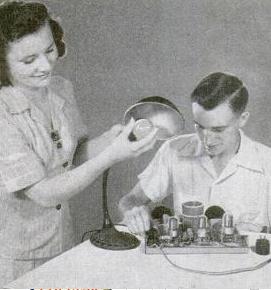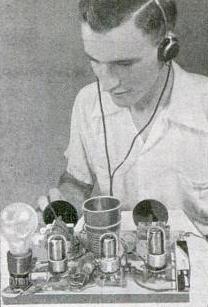 Wartime parts shortages were a major inspiration for the design of this short wave receiver from the January 1945 issue of Popular Mechanics. The lamp isn’t there for decoration; it’s one of the parts.
Wartime parts shortages were a major inspiration for the design of this short wave receiver from the January 1945 issue of Popular Mechanics. The lamp isn’t there for decoration; it’s one of the parts.
The receiver used three identical tubes, the 6C5. It ran directly off house current. The three 6-volt filaments are run in series, and to avoid the need for a filament transformer, a 40-watt light bulb in series is used to drop the 110 volt house current to the 18 volts necessary to light the tubes. A standard household receptacle is mounted directly on the chasis, into which a desk lamp can be plugged. Another alternative was to mount the bulb directly on the chasis, using a lamp adapter plug.
Speaking of the chasis, the set is constructed on a literal breadboard, sourced from the nearby dime store. The coil form was also obtained at the dime store, in the form of a plastic drinking cup. The coil is wound with cotton-covered wire, held in place with fingernail polish.
 The two variable condensers, one for tuning and the other for regeneration, were scavenged from old broadcast receivers. For regeneration, only half of the 350 mF condenser is used. For tuning, the two sections of the 350 mF condenser are wired in series, rather than parallel, resulting in 88 mF, which is better suited to the 25 and 31 meter bands the set tunes. An additional five resistors and five capacitors round out the parts list.
The two variable condensers, one for tuning and the other for regeneration, were scavenged from old broadcast receivers. For regeneration, only half of the 350 mF condenser is used. For tuning, the two sections of the 350 mF condenser are wired in series, rather than parallel, resulting in 88 mF, which is better suited to the 25 and 31 meter bands the set tunes. An additional five resistors and five capacitors round out the parts list.
One of the 6C5 tubes is used as a rectifier, one serves as the regenerative detector, and the final one serves as an audio amplifier. In the 1943 Allied Radio catalog, the tubes are available for 56 cents each. The catalog notes that most glass tubes were available in limited quantities. However, it noted that the metal tubes were generally available only to high priority customers.
Click Here For Today’s Ripley’s Believe It Or Not Cartoon
![]()
